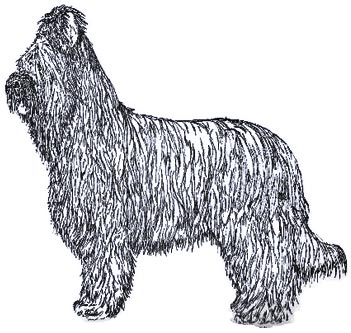 The Briard is an old breed with centuries of tradition and work ethic. Almost lost during the periods following WWI and WWII, dedicated modern breeders have brought them back, and are entrusted with the welfare and continuance of the breed. At Eiledon Briards we do our best to carry on where others have gone before us.
The Briard is an old breed with centuries of tradition and work ethic. Almost lost during the periods following WWI and WWII, dedicated modern breeders have brought them back, and are entrusted with the welfare and continuance of the breed. At Eiledon Briards we do our best to carry on where others have gone before us.
The Briard is depicted in artwork dating from 8th century France. Charlemagne, Napoleon, and Lafayette are all said to have owned Briards. The breed was originally used for protection from predators, while later examples were bred to enhance herding skills, and are used for this purpose still today. They are dogs that are happy to work. In addition to herding and guarding the flock, Briards were used by the French Army during both World Wars as sentries, messengers, and to search for wounded soldiers. Other Briard occupations include search and rescue, police work, acting in cinema and television, therapy dog work, and of course, serving as beloved family pets and watch dogs.
Thomas Jefferson brought the first Briards to America, where he used the dogs to tend his flock of Merino sheep at Monticello. He became acquainted with the breed while serving as Minister to France from 1784 to 1789.
A French society, Les Amis du Briard, was established in 1909, and eventually defined a set standard for the breed in 1925. This original standard is the basis of the breed standard used today by the American Kennel Club (AKC) when judging Briards in the show ring. A litter bred in Massachusetts in 1922 were the first Briards registered in America by the AKC.
The Briard has a double coat. The outer coat is coarse, hard and dry, making a rasping sound when rubbed between the fingers. The outer coat is naturally long and slightly wavy. It provides protection for Briards working in the field, and readily sheds mud and dirt. The undercoat is fine and tight to the body. Regular grooming is necessary to keep the coat in good condition and prevent matting. Color variations include black, grey and tawny.
As with many French herding breeds, Briards possess double dewclaws mounted low on both rear legs. Each dew claw should have bone substance and nail. Some veterinarians have been known to recommend removal of dew claws, but this is a very bad recommendation that should never be followed unless the dog has in some way injured itself. Dews claws with improper bone structure, or absent, will result in immediate disqualification in the show ring.
The Briard’s tail is well-feathered, and carried low with a distinctive J-curve at the end, known as the crochet. When the dog is in motion, the tail is raised in a harmonious curve, never going above the level of the back, except for the terminal crook.
Briards are quick to learn, for good or for bad. Training and socialization should begin at a young age in order to establish good habits and behavior. Training and behavior management needs to always be consistent and kind. A Briard left to its own devices without firm, fair guidance, will naturally assume that it is in charge, which will not make for a happy life for either dog or owner.
Briards are not the breed for every household, but for those with time, attention, and affection to give, the Briard is a loyal and entertaining companion. They have often been described as ‘a heart wrapped in fur.’

